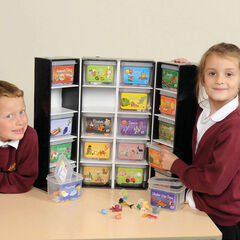I Don’t Know What to Write…
One resource that can provide endless learning opportunities are the Creative Writing Tubs.
You know the bit in a writing lesson where your pupils sit at their tables ready to begin writing their story? Yep, that bit! I love that bit! I find this to be an exciting time in the lesson. Watching all the hard work you have done to inspire a truly imaginative and well-crafted piece of writing coming out of your pupils’ pencils.
There is always a magical sense of teacher anticipation as you wait to see what they will produce. Whilst you wait for an award-winning author to emerge from your lesson you often spot that one child. The one child who, despite your best endeavours to inspire with pictures, videos, examples and just about anything else, looks at you with big appealing eyes and says: ‘I don’t know what to write.’ It’s these children who need that extra bit of inspiration, perhaps something more tangible and real.
The Creative Writing Tubs offer just that – a kit packed full of unique, engaging objects, artefacts and characters to inspire fiction and non-fiction writing to get the creative juices flowing.
One Resource Endless, Learning Opportunities
As with all good resources there is more than one way that we can use this kit to provide many learning opportunities. Here are a few ideas, especially for those children who don’t know what to write:
- Select a tub – Ask your pupils to select a tub that they like the look of or that represents a topic that they find personally motivating. Explore the content of that tub and ask the pupil to choose their three favourite things. Discuss their three choices in terms of Who? What? Where? This can provide a powerful start to their writing.
- Creating a setting – To develop descriptive writing, think multi-sensory. Provide the pupils with the contents of a tub and ask them to pick an item that represents a place. Explore the item that they have selected based upon what they can see, what they might hear, what they could smell, taste and feel. They now have the start of a setting description. You can then introduce a character from the tub.
- Questions – Pose ‘what would happen if?’ questions to inspire using two items from the same tub. For example, using the space themed tub: What would happen if this alien met this spaceman? This can be developed using the other objects. For example, when using the other objects in this tub think about, ‘Where might they go? How could they get there? What would they do there? Every answer the child needs is in the tub. Let them play it out using the objects to rehearse their answers.
- Creating a story plan – Sort and sequence the objects in the tub into a tangible story plan. The objects could be placed into a writing frame or story map to support the pupil in recalling all the elements of their story.
- Role-play – Create a short role-play in which the objects become the characters, location and props. Pupils can rehearse telling their story using the objects until they feel comfortable to write it down. This could be filmed for playback to support recall when writing.
So next time a pupil isn’t sure about what to write give them an actual thing to hold, explore. Give them Creative Writing Tubs. You never know, you might just inspire the next budding William Shakespeare!
Thank you to Beccie Hawes for writing this blog for us.
Beccie has worked in all aspects of Special Educational Needs including mainstream, additionally resourced provision and specialist settings. She has extensive experience as a SENCo, Inclusion Manager, Lead Local Authority SEND Advisory Teacher and has set up and led an inclusion advisory service.
Beccie is currently proud to be the Head of Service with Cadmus Inclusive, part of Cadmus Services, which is based in Walsall. This service has a national reach and actively supports schools with all aspects of providing a high quality education for vulnerable learners. Beccie is the author of ‘The Complete Dyslexia Toolkit’ and co-author of ‘Getting it Right for SEND’ and ‘How to Create the Perfect Partnership with Parents’. Beccie also writes the national Ebriefing: SEND Bitesize. She has developed a number of educational resources to support learners which schools across the UK have purchased and use. Beccie remains very ‘hands on’ in the classroom and is passionate about being at the chalk face to support teachers and children to think differently for a brighter tomorrow. She is also the mum to four boys and a dog.







